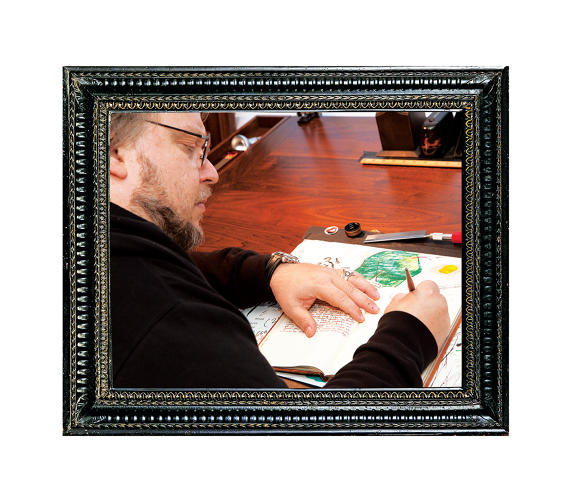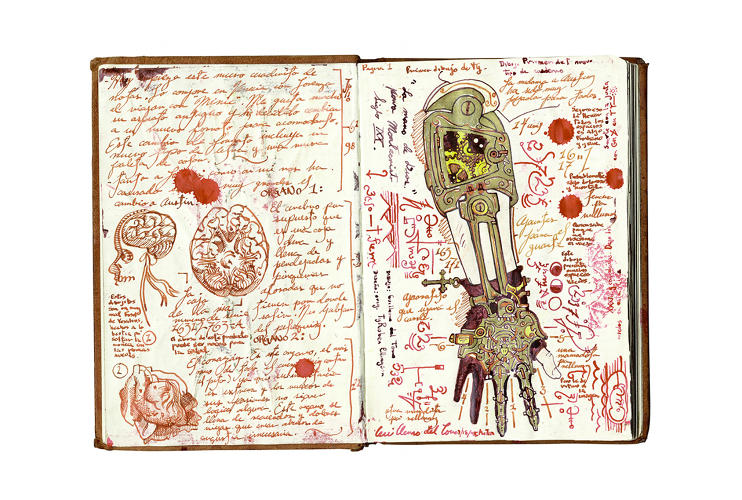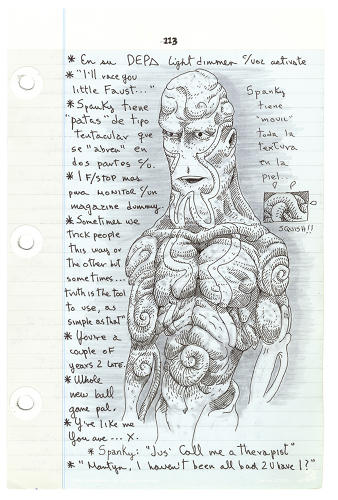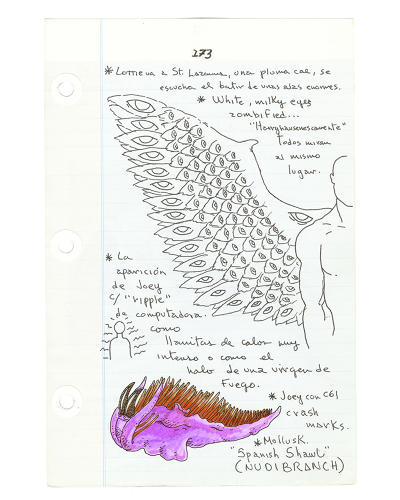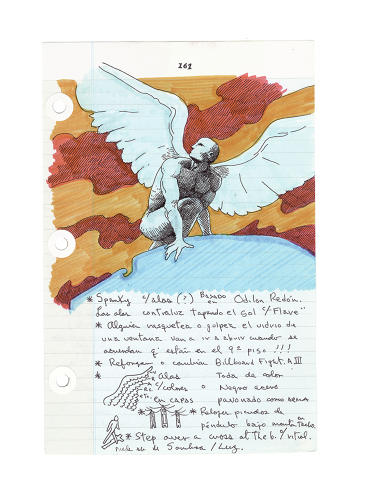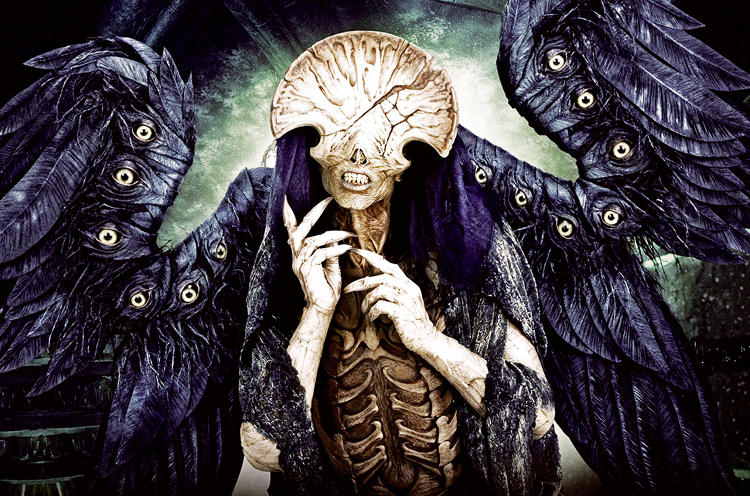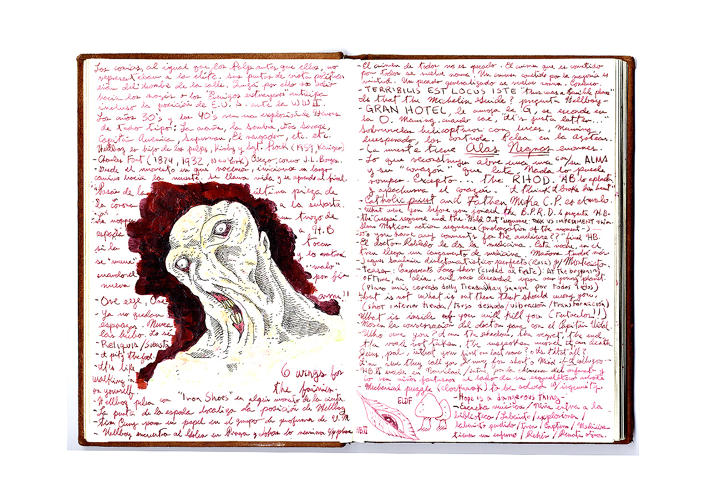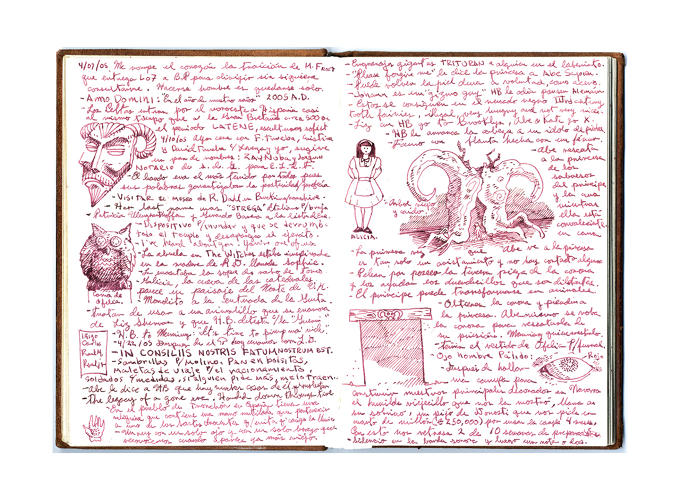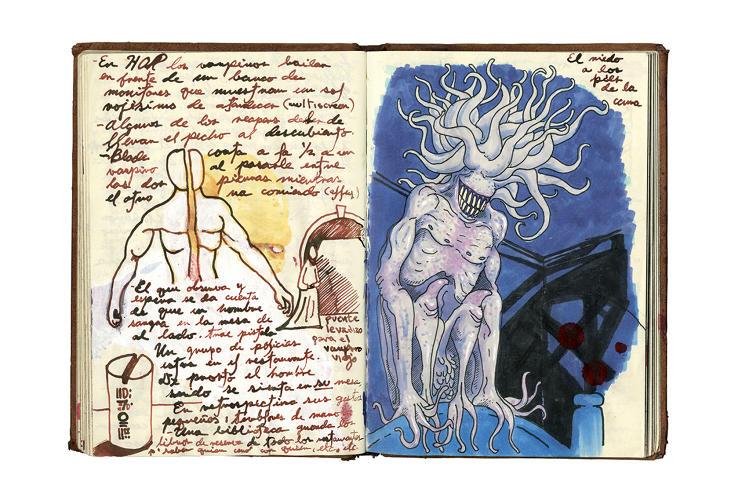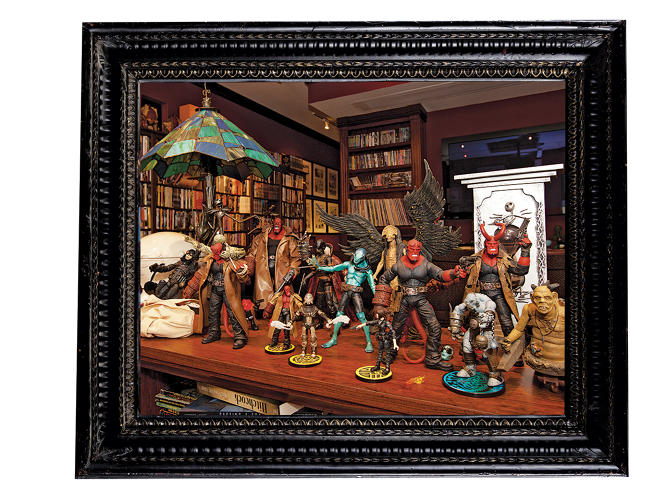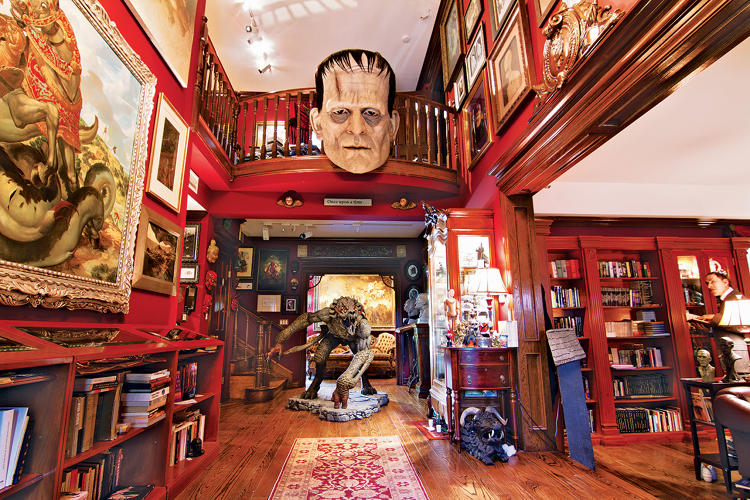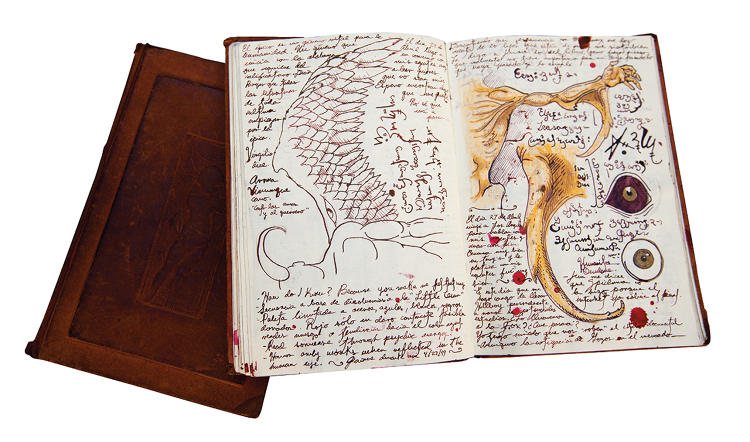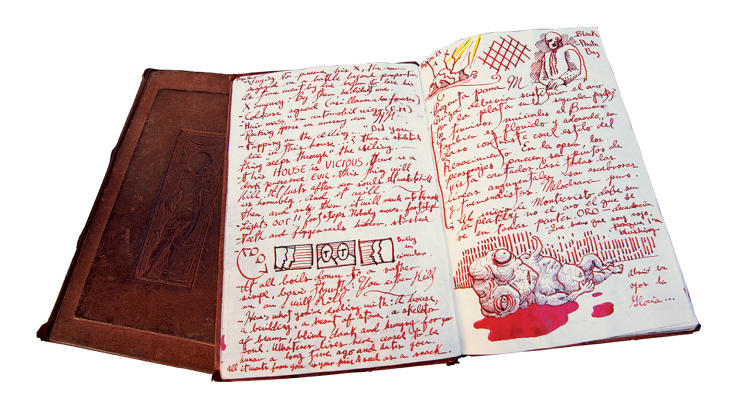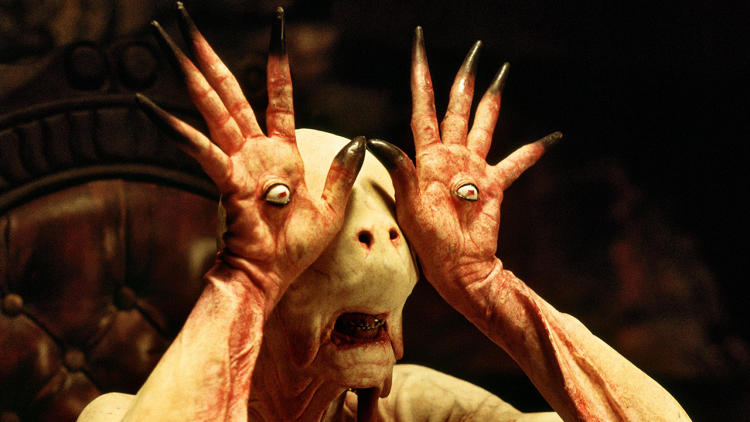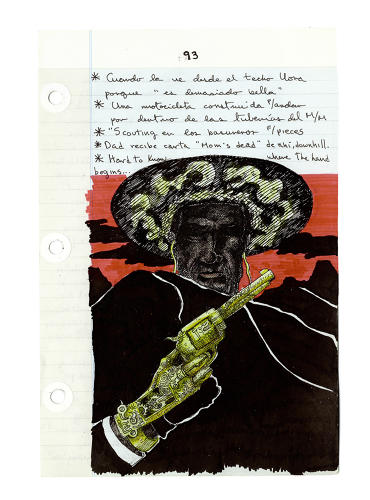When Guillermo del Toro was four years old, his father won the lottery and moved the family to a better house in Guadalajara, Mexico. That’s the last time dumb luck seriously impacted the visionary horror maestro’s brilliant career.
Equipped as a child with a prodigious imagination and ferocious curiosity, del Toro tore through a book a day, crafted plastic internal organ facsimiles with his brother, taught himself to draw at age seven and sold color-penciled comic booklets to family members. In his teens, del Toro worked next door to a morgue, consumed comics by the tens of thousands and watched hundreds of monster flicks at the local cinema.
Del Toro honed his eye for the gory detail by designing makeup and effects for his Necropia company before directing his own Spanish language horror films including Cronos and the haunted orphange thriller The Devils Backbone.
When Hollywood came calling, del Toro populated two Hellboy movies with extraordinarily freakish villains. In 2006 he pulled from Greek mythology and fairy tale traditions to illuminate the Oscar-nominated Spanish Civil War fantasia Pan’s Labyrinth.
A dry spell followed. Peter Jackson hired del Toro to direct The Hobbit but decided ultimately to helm the franchise himself. Del Toro also spent a year developing Tom Cruise’s still un-made At The Mountains of Madnessproject.
Last summer del Toro returned to form with the visually bruising monster-versus-robot slamfest Pacific Rim. He’s now producing FX Networks’ vampire-themed TV movie The Strain and prepping Jessica Chastain’s 2014 horror movie Crimson Peak. Further down the road: a new Pinocchio.
All along the way, del Toro has been sketching monsters, devices, doodles, and random visuals in notebooks he describes as “idea incubators.” A selection of those drawings now go public in Guillermo del Toro’s Cabinet of Curiosities: My Notebooks, Collections, and Other Obsessions (out Oct. 29 from Harper Design).
Speaking from the Los Angeles suburbs, where he lives with wife and two daughters a few blocks from his memorabilia-filled “Bleak House,” del Toro talks to Co.Create about pilfering ideas from his younger self, the horror of biology, his love/hate relationship with the color red and the importance of drilling beneath pop culture surfaces to tap fearsome ancient traditions.
KNOW WHAT CAME BEFORE, PART 1
In order to have a voice you have to reach inside you and be completely yourself; but, to paraphrase Stephen King, all the songs have been sung. It helps if you’re aware of all the singers that came before you so you can be rooted in tradition and then push it to a new place. That’s the only thing we can offer: a new voice in a really, really old tale.
When you trace back fantastic imagery, you’re going to stumble upon Marcel Schwob and Odilon Redon; you’re going to stumble upon Dadaism, surrealism, symbolism, then you go all the way back to Mesopotamian sculpture and Egyptian murals. That’s the great thing about the fantastical narrative–it’s been with us since the origins of our culture and that gives you a spring board for not just trying to do what is being done right now.
GET THE GORE RIGHT
When I was eight years old I read The Family Health Medicine Encyclopediaand instantly introspected every disease. I thought ‘Oh my God I’m dying!’ I was the world’s youngest hypochondriac because I was absolutely sure I was dying of trichinosis, of cardiac arrhythmia.
We’re shooting The Strain now and I talked to the actress about the stinger of the vampire injecting hair-thin worms into their hosts. I’m telling her they’re like Dirofilaria immitis, which is the heart worm that lives in the hearts of dogs, and she was completely disgusted, but for me it’s completely natural to talk about parasites by their scientific name and know that they have very simple, collagen bodies and atrophied digestive systems. All of that starts with biological curiosity.
UNDERSTAND THAT BIOLOGY IS HORROR
The most intimate betrayal of every human being starts in her body or his body. From the moment we’re born, we already have a cancer gestating or an atrophied muscle or a malformed vein or aorta. We are almost like spirits or minds that are being hosted in a bag of meat that is treacherous.
Biology as horror is an anxiety that comes with modernity. I don’t think Egyptians felt anxiety about that. Their cosmology had to do with the skies and dawn and death, but our cosmology right now is colon cancer, lung cancer–these are the demons we really fear. Viruses. Anthrax. This is the language we speak now and therefore biology is at the same time fascinating and incredibly horrifying.
KNOW WHAT CAME BEFORE, PART 2
The more you dig beyond the pop culture roots of horror, the more you find things that make you think differently from everybody who’s doing horror in a contemporary fashion.
When you go back to horror of the 1970s and the 1980s, you track that back to the pulp magazines, then you trace those back to Victorian horror, then you go back to the origins of Gothic romance and keep going back to the tales that become folklore. You go through Victor Hugo and The Man Who Laughs and Charles Dickens with his many ghost stories, you go through Henry James and Shirley Jackson and Oscar Wilde. You go through a lot of writers that people who are only obsessed with the pop culture representation of the genre don’t normally take into account.
SCHOOL YOURSELF IN LIFE
Film school is incredibly valuable because you’re surrounded by an atmosphere that’s conducive to making films, but the danger is to think that you’re going to have something to say just by experiencing film. I know only one filmmaker who truly seems to live in a world of movies and that’s Quentin (Tarantino). He can talk about Alan Ladd or Robert Mitchum as fluently as if he were talking about a cousin or an uncle. But Quentin’s an exception.
Scorsese, a huge student of film, grew up very fragile in a really tough neighborhood so he was definitely vetted by a lot of life influences.
I identify with my very particular upbringing as a lapsed Catholic and the relationship I had with violence and death growing up in Mexico. When people ask me, “Why are you drawn to unborn things or things in a jar?” well, it comes from my childhood when I was exposed to biological parts in jars in school or when I worked as a teenager next door to a morgue. These are strange experiences but they shape who you are. They are connected not to a pop reference archive but to a live archive and cultural archive that goes deep.
All I’m saying is, there’s no substitute for being sculpted by life. You need to feel the pain, or the absence, or the presence of something evil or whatever it is, and then you need to articulate that through film or novels or painting or whatever craft is available to you.
THINK VISUALLY
I find things in my notebook–things that I have a hard time explaining without an elaborate drawing. For Pan’s Labyrinth, I copied a sculpture that make up effects company DDT had done of the Pale Man. He had eyes and a nose and a mouth. I copied that in my notebook and then I erased the face and sent it back to them. There was no way I could have verbalized why it was going to work unless I sketched it but I knew it was going to work.
I was really afraid of manta rays when I was growing up as a kid and when you flop a manta ray on its back, it has the little little mouth and the two little nostril-like openings. They were so creepy.
KNOW WHAT CAME BEFORE, PART 3
If you’re trying to make a monster by imitating, say, Ray Harryhausen, then you immerse yourself in Harryhausen and find out he was inspired by the French engraver Gustav Doré. Then you find out Doré was inspired by neo-classical sculptures and engravers so you go there and little by little you wind up looking at rough 14th-century illustrations. You see an olive-skinned devil with a face on its ass and you realize, ‘Oh my God this works because it’s simple.’ You have to always try to express the creature in its purest form.
SIMPLIFY THE SCARE
Look at a lion. It’s very elegant; but when the lion gets angry, it’s scary as fuck. Look at a shark. It’s basically a mouth with a tail to support it, and that’s very scary.
When young kids compete to design make up effects or a new monster, the salient defect I find is that it has horns and wings and hairs and teeth and evil eyes and a lot of scales and pus and sores. It becomes impossible to admire or love or be in awe of because so much has accumulated. You need to be selective. You need to decide what the design represents, even if the form is somewhat baroque, and ask yourself “How can you do it economically?” You have to figure out how to best communicate the idea in its simplest form.
MESSY IS OKAY
(Hell Boy comic creator) Mike Mignola told me that Frank Frazetta used to paint with the gnarliest, ugliest looking brushes he’d ever seen. When Mike goes to a studio and sees all the Prismacolor (colored pencils) that are pristine and all the beautiful brushes that are clean, he says that’s the sign of someone who doesn’t work enough. That’s the sign of someone who wants to look like a painter more than be a painter. It’s incredible how much the craft of the designer winds up being not in the tools but in the soul.
STEAL FROM YOUR YOUNGER SELF
What’s great about a sketch book is, you put drawings in it and then they’re there. You carry them with you and consult them and thieve from yourself. There’s something about that guy at 28 or 35: he’s smarter or fresher than you are at 40 but he’s somebody who understands you perfectly, because it’s you.
In a sketch book you can distill your compulsions, because I believe every artist is just the sum of his or her compulsions. Keeping a catalog of those obsessions through the years, you steal from someone who is almost electrically alive with those same compulsions at age 21. That makes the dialogue very fluid. I revisit the books before every project.
I showed somebody this illustration of a heart with a parasitic thing growing around it that I did in 1992 and it’s almost exactly the sculpture of a vampiric heart we used on The Strain last week. I laughed because here we are 21 years later and now it’s a piece of make up effects.
COLOR WITH CARE
In a film you can art direct anything to be an expressive part of the storytelling so it’s incredibly important to codify color. The rule I start with is that red should be used very very pointedly. You need to be careful about what it means. In Pacific Rim, red was life, represented by the little shoe of the girl Mako Mori–Rinko Kikuchi–in Tokyo. Mako doesn’t recuperate the red color until the end of the movie when she and Charlie Hunnam end up bathed in red. These are little things you can codify in a painterly way in movies. Nobody needs to notice, but you know.
MAKE A TRANSCENDENT MOMENT
Some of the most memorable fantasy film images come not from greatest screenplays or stories but from quickie B movies where the image was coded so strongly that it stood above and beyond the content.
The Gill Man in Creature from the Black Lagoon is, you could argue, sort of a mixture of Beauty and the Beast and King Kong with a touch of this and that, but the creature swimming underneath Miss Adams in her white suit is one of the sexiest and most beautiful moments in film history. It rises above and beyond anything else in the movie. It’s a purely cinematic moment of communication.
EMBRACE FAILURE
I think it’s essential to fuck up. I think of failure as latent success. Any experience in life is neutral. You can tint it as a piece of learning or you tint it as a piece of misinformation.
I thank God for the two years I spent in New Zealand working on The Hobbit, scouting, designing, breaking bread with the geniuses at WETA, having afternoons of elucidating stories with Peter (Jackson), Phillipa (Boyens) and Fran (Walsh). I can not measure it only by: ‘Did I direct the movie or did I not direct the movie?’ I grew up as a filmmaker.
Now, is it a heartache? Oh yeah. It’s huge. It’s painful. But you learn from it. If all you think about is success rather than fulfillment, that’s a dangerous coin you’re dealing with. That kind of success has a horrible exchange rate of currency. Horrible. It’s never going to be enough to pay the debts you have in your soul as an artist.
FIND YOURSELF IN THE STORY
We tell stories because we have a hollow place in our heart. You don’t fill that with success.You fill it by finding yourself in the stories you tell. They can be viewed by 10 people, or they can be viewed by 10 million people.
When we showed Cronos to the head of the Mexican film Institute, he said this movie’s going to go nowhere blah blah blah. I memorialized that day in my notebook because I said “I have to out live this day.”
Everybody reads the reviews; it’s inevitable. But how you end up filing that in your heart is very important. Don’t file it under “I must stop.” File it under “Fuck it, I’m going to prevail.”
Take a look inside del Toro’s sketch book in the gallery above.


